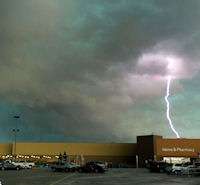Tornadoes: April is the cruelest month

In the opening lines to The Waste Land, T.S. Eliot wrote "April is the Cruelest Month."
You might agree if you live in the southeastern United States. Last April, a historic outburst of 202 tornadoes turned broad swaths of that part of the country into a disaster zone.
"The event of April 27th and 28th 2011 was the costliest convective storm in U.S. history," said Kevin Knupp, professor of atmospheric sciences at the University of Alabama-Huntsville. And he doesn't just mean costly in terms of property damage -- 316 people lost their lives.
Of the 202 twisters that day, 62 tore through Alabama, where Knupp works. Ten of them were ranked EF 4 and 5 on the Enhanced Fujita Scale. Three tornadoes churned paths more than 120 miles long, and a large number of the twisters cut swaths more than a half mile wide.
Knupp saw the results first-hand, and he’s been studying them ever since. Aided by a team of graduate students and colleagues, he’s sifted through gigabytes of data1 collected by NASA and NOAA satellites and local ground sensors. A year later, they have drawn some interesting conclusions.
One discovery was how rapidly an EF-5 spun up near the small town of Hackleburg, Alabama.
This is a video version of this story.
"The Hackleburg storm got its act together really quickly," says Knupp. This particular twister formed only 50 minutes after the underlying thunderstorm appeared. For comparison, the average time for tornado formation is 2 hours. The twister blasted through north Alabama with winds over 200 mph, killing 72 people.
Knupp’s team believes that something called a "thermal boundary" set the stage for the birth of the killer. Cool, moist air on one side of the boundary formed a low cloud base –“kind of like a wall,” he explains. Warm air from the storm ran into the wall and swept upward. Updrafts are a key ingredient of tornadoes. In this case, updrafts as swift as 75 feet per second were recorded.
They also noticed that many of the tornadoes seemed to cluster in space and time. Knupp offers the example of Arab and Guntersville, neighboring communities not far from NASA’s Marshall Space Flight Center: "16 tornadoes touched down in the area -- 13 of them in a half hour period."
Could local topography have attracted the twisters?
There does appear to be a link between the shape of the landscape and the path of these tornadoes.
"Arab-Guntersville is in a valley between two mountain ridges, and valleys can channel the flow of air, like in a breezeway," notes UA-Huntsville atmospheric scientist Tim Coleman, a member of the research team.
Coleman also noticed a correlation between the slope of the terrain and the onset of damage tracks. "Winds intensified on the downward slopes of mountains in the area—and that is sometimes where the damage path starts." He has observed this phenomenon in past tornadoes in east Tennessee and southern Virginia.
This tornado-topography hypothesis might seem obvious, but researchers have not always had enough data to test it—that is, not until April 2011.
Prompted in part by the outbreak, Coleman has studied tornado paths all over the southeast and found some interesting repeats. For example, just north of Birmingham, several violent tornadoes have tracked within a 10-mile wide band since 1977. A similar track appears to the north and west of Huntsville.
"More research is needed to see if topography really plays a role," cautions Coleman. "The more we can learn, the more accurate we can make tornado warnings."
They’re likely to get more data in the near future. It is April, after all.
Provided by Science@NASA



















